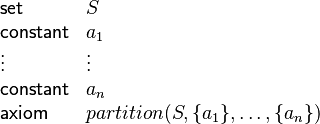Changes to the Mathematical Language of Event-B: Difference between revisions
imported>Nicolas mNo edit summary |
imported>Nicolas |
||
| Line 53: | Line 53: | ||
== Partition == | == Partition == | ||
{{ | A new partition predicate is introduced. It is intended to provide an easier way to enter enumerated sets, while getting rid of the <math>\frac{n(n-1)}{2}</math> axioms needed to express pairwise distinctness (or disjointness). The partition operator is defined as follows: | ||
<math> | |||
\begin{matrix} | |||
partition(E_0, E_1, \ldots, E_n)\defi & | |||
E_0 = E_1\bunion \cdots\bunion E_n \\ & | |||
\;\land\; E_1\binter E_2=\emptyset | |||
\;\land\;\cdots | |||
\;\land\; E_{n-1}\binter E_n = \emptyset \\ & | |||
(\;\land\; i \ne j \limp E_i \binter E_j = \emptyset ) \\ | |||
\end{matrix} | |||
</math> | |||
where the <math>E_i</math> are expressions bearing the same type. | |||
Then, we can enter into a context : | |||
<math> | |||
\begin{array}{ll} | |||
\mathsf{set} & S\\ | |||
\mathsf{constant} & a_1\\ | |||
\vdots & \vdots\\ | |||
\mathsf{constant} & a_n\\ | |||
\mathsf{axiom} & partition(S, \{a_1\}, \ldots, \{a_n\}) | |||
\end{array} | |||
</math> | |||
== Operator Associativity == | == Operator Associativity == | ||
{{TODO}} | {{TODO}} | ||
Revision as of 15:21, 12 March 2009
This document describes the evolution of the Event-B mathematical language that will soon take place. The previous version of the language will still be supported.
Identity and Projections
Three operators were still unary while they could be atomic:
- the identity relation

- the first projection

- the second projection

These operators are defined as follows:

If we drop the parameter, we get much more straightforward definitions that capture the essence of the operator. The new definitions are

We have the following equivalence between the old and the new versions of the operators

Moreover, in the case where the parameter is not needed, then it can
be dropped altogether: no domain restriction is needed. For instance,
to express that a relation  is irreflexive, one would now write
is irreflexive, one would now write
 .
.
Partition
A new partition predicate is introduced. It is intended to provide an easier way to enter enumerated sets, while getting rid of the  axioms needed to express pairwise distinctness (or disjointness). The partition operator is defined as follows:
axioms needed to express pairwise distinctness (or disjointness). The partition operator is defined as follows:
where the  are expressions bearing the same type.
are expressions bearing the same type.
Then, we can enter into a context :
Operator Associativity
TODO

